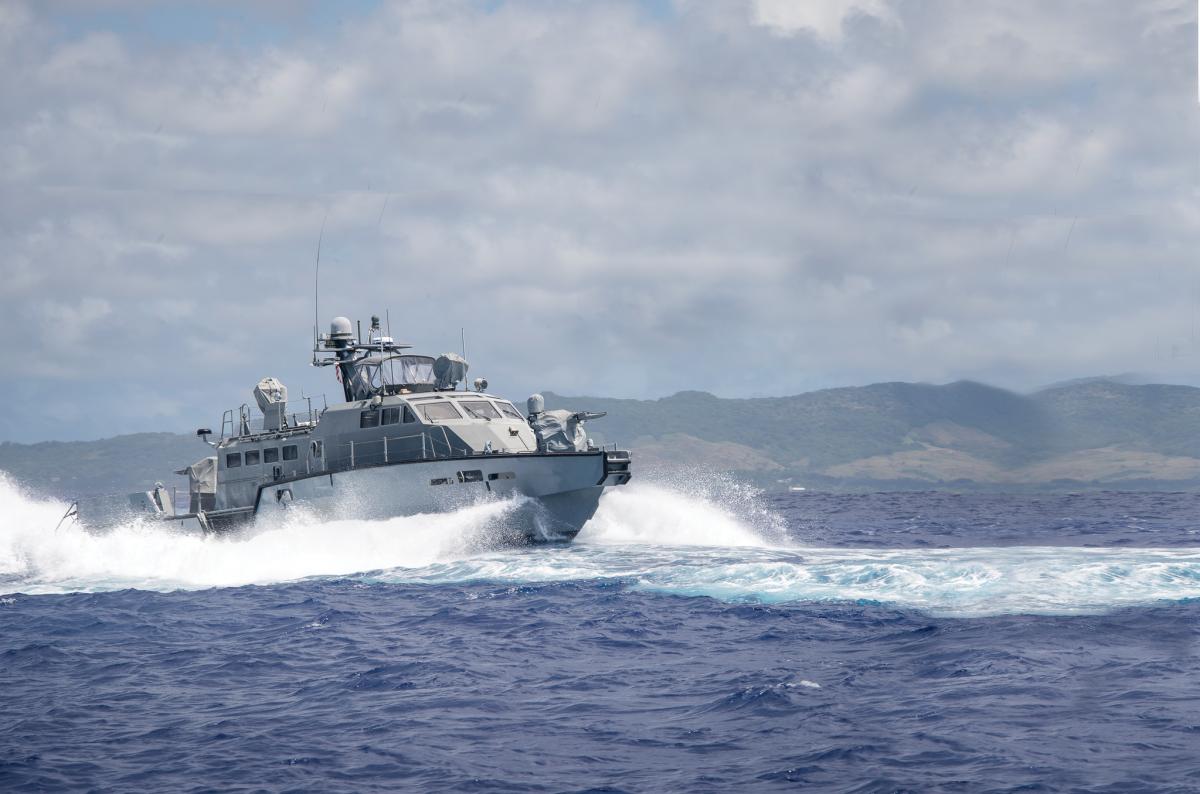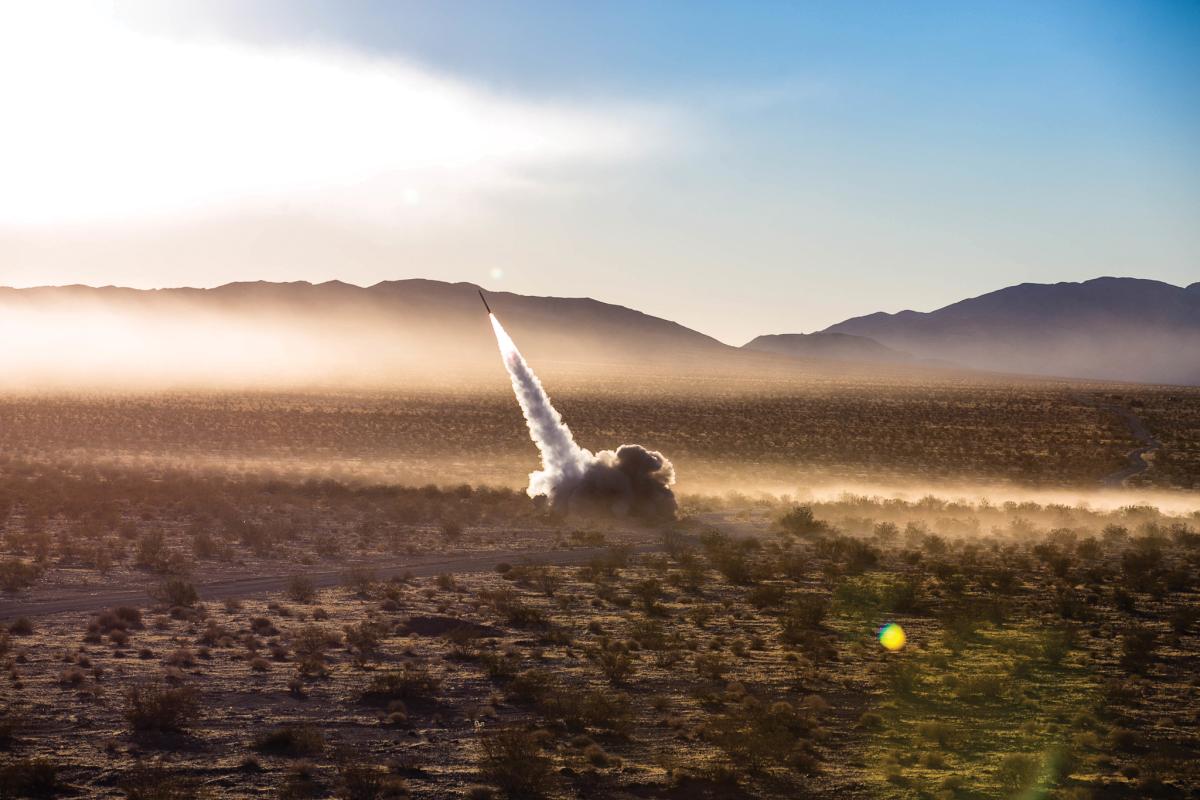Chief of Naval Operations Admiral John Richardson and Commandant of the Marine Corps General Robert Neller signed the “Littoral Operations in a Contested Environment” (LOCE) concept document in 2017 to recognize formally the need for greater and more effective integration between the Navy and Marine Corps to “overcome emerging threats within
littoral areas that are rapidly expanding in operational depth, complexity, and lethality.”1 The document “describe[s] naval operations in the littoral environment in light of emerging threats in order to provide a unified framework for Navy-
Marine Corps innovation.”2
Among the ideas it advances is the conduct of expeditionary advanced base operations (EABO), which are designed to distribute lethality by providing “land-based options for increasing the number of sensors and shooters beyond the upper limit imposed by the quantity of seagoing platforms available.”3 EABO forces would do so as an integral component of a naval operation to “control, or at least outpost, key maritime terrain to improve the security of sea lines of communication or chokepoints or deny their use to the enemy.”4 These ideas have deep roots in the Navy–Marine Corps team’s history.
Marine Corps Defense Battalions
In the late 1930s, the Marine Corps created the first of 20 defense battalions that eventually served during World War II. Initially envisioned as fixed-defense forces, they evolved into flexible, rapidly deployable, multidomain forces.
The 5th Defense Battalion landed on Iceland in July 1941 as part of the 1st Provisional Marine Brigade augmenting the British occupation force. Five months later, Marine defense battalions experienced combat for the first time during the attack on Pearl Harbor. Hours later, a 1st Defense Battalion detachment augmented with a Marine fighter squadron (VMF-211) fired the first shots in the defense of Wake Island. The defenders were credited with sinking two destroyers, two transports, and two patrol boats, while downing or damaging as many as 20 aircraft.
As the war progressed, the number of defense battalions grew. They served across the globe from the North Atlantic to Guantanamo Bay, Hawaii, and the Solomon Islands, and on to the Central Pacific.5
The battalions were built around the ability to find and fight targets at sea and in the air, as well as to provide local defense. The sensors and weapons within the defense battalions evolved over the course of the war to better meet mission requirements.6 Initially equipped with searchlights and aircraft sound locators, they eventually were equipped with first-generation radar sets. A coastal defense group normally
employed 5-inch/51-caliber naval guns, while an antiaircraft group was composed of four batteries of 3-inch naval guns. The group also had two dozen .50-caliber machine guns for air defense and a similar number of .30-caliber machine guns for beach defense. It was not uncommon for defense battalions to be reinforced with aviation or infantry units, task-organized to suit each mission. These battalions provided a potent landward complement to naval combatants and were an essential component for sea control and sea-denial operations.
Integrated Naval Operation: Guadalcanal
The July 1942 “Joint Directive for Offensive Operations in the Southwest Pacific Area Agreed on by the United States Chiefs of Staff” established the objective to seize and occupy the New Britain–New Ireland–New Guinea area to deny it to Japan.7 Chief of Naval Operations Admiral Ernest J. King and Army Chief of Staff General George Marshall signed the document.
The joint directive identified three initial tasks. First was an integrated naval operation, the seizure and occupation of the Santa Cruz Islands, Tulagi, and adjacent positions such as Guadalcanal. The second and third tasks involved moving into the central Solomons and then to Rabaul. The plan also specified, “Direct command of the tactical operations of the amphibious forces will remain with the Naval task force commander throughout the conduct of all three tasks.”8
By 8 August, the Marines had secured their initial objectives, including the seizure of the Japanese airfield under construction on Guadalcanal. The U.S. forces continued to fortify defensive positions, completed the airfield by 18 August, and received their first aircraft by 20 August at newly named Henderson Field.
For the next six months, the 1st Marine Division provided a persistent ground force within range of Japanese land, sea, and air threats that enabled the small force of pilots and aircraft—the “Cactus Air Force”—to operate from Henderson Field, which allowed the Allied naval force to gain and maintain air superiority over Guadalcanal and the waters surrounding the islands. (“Cactus” was the Allied code name for the island.) These operations demonstrated the advantages of forces persisting and operating within an enemy’s contested weapons-engagement zone.
The effectiveness of this inside force was enhanced by the networked, persistent observations of Australian coastwatchers on Bougainville and New Georgia islands. These observers provided advance notice of Japanese ship and aircraft movements, greatly enhancing Navy and Marine Corps air operations. The local air superiority generated by the Cactus Air Force translated into localized daytime sea control and forced the Japanese into more predictable night movements. These factors allowed the U.S. Navy to predict when and where they could surge fleet units from outside the weapons-engagement zone to attack the Japanese Navy in night surface actions. This series of fierce battles eventually forced the Japanese to abandon plans to retake Guadalcanal, and the island was declared secured on 9 February 1943.
Historian James D. Hornfischer, in his classic Neptune’s Inferno, summarized the significance of the Allied victory in the Guadalcanal campaign:
In their trial against the Imperial Japanese Navy in the waters off Guadalcanal, the Navy mastered a new kind of fight. Expeditionary war was a new kind of enterprise, and its scale at Guadalcanal was surpassed only by its combatants’ thoroughgoing deficits in materiel, preparation, and understanding of the enemy. It was the most critical major military operation America would ever run on such a threadbare shoestring. As its principal players would admit afterwards, the puzzle of victory was solved on the fly and on the cheap, in terms of resources if not lives. The campaign featured tight interdependence. . . . For the infantry to seize and hold the island, ships had to control the sea. For a fleet to control the sea, pilots had to fly from the island’s airfield. For the pilots to fly from the airfield, the infantry had to hold the island. That tripod stood only on the strength of all three legs. In the end, though, it was principally the Navy’s battle to win. . . . Its outcome was often in doubt.9
Forward from the Past
The Allied defeat of Japan’s sea-control/sea-denial strategy began with an integrated Navy–Marine Corps effort. Under the direct command of a naval task force commander, Marines and sailors synergistically fought on the land, at sea, and in the air to secure sea lines of communication and deny key maritime terrain to the enemy. Operating cohesively enabled the Navy to regain control of the seas in hotly contested littoral areas. Although threats and capabilities have advanced since World War II—and complexity has been added with space, cyberspace, and electromagnetic spectrum operations—the fundamental challenges presented by terrain, topography, and a determined foe remain relevant.
Crucial insights from the victory at Guadalcanal can be gleaned regarding the necessity of a dual posture—resilient forces operating inside the enemy’s weapons-engagement zone, and decisive forces outside that zone with the ability to surge forward at opportune times to deliver devastating blows. The same sort of dynamic and complementary inside-outside relationship present at Guadalcanal can work today to offset the inherent advantages of 21st-century sea-control/sea-denial strategies.
EABO Future Development
The fight for Guadalcanal and “Littoral Operations in a Contested Environment” suggest some essential characteristics of a force able to persist inside an adversary’s weapons-engagement zone.
Such a force must operate from dispersed, resilient, expeditionary locations to complicate adversary targeting. It will need to master cover, concealment, and deception, along with signals management, to survive and thrive within the arc of adversary precision long-range fires and sensors. It will need to operate self-sufficiently in austere environments, as even a modernized, more resilient sustainment enterprise will be hard-pressed to support distributed operations in contested environments. Creating the virtue of mass without the vulnerabilities of concentration, a force with these characteristics should be able to generate disproportionate results.
An EABO force operating from temporary locations ashore also might be used to increase naval intelligence, surveillance, and reconnaissance (ISR) assets, coastal-defense cruise and antiship missile launch nodes, and air-defense capabilities. It could establish forward arming and refueling points and temporarily support operations and sustainment activities for aircraft; critical munitions reloading teams for ships and submarines; and expeditionary basing for surface screening/scouting platforms. These would provide the opportunity to use the strength of its tactical defense to create denied space for an adversary. Putting “hard to find, hard to hit” operationally relevant forces inside the arc of the adversary’s precision long-range fires and ISR capabilities would allow the fleet or joint-force maritime component commander to preserve capital ships for more decisive operational and strategic maneuver and effects.10
Although this discussion focuses on operations in conditions of armed conflict, these same forces and capabilities have a significant role in competition short of that. The deterrent value of these expeditionary operations, for example, could confound a potential adversary’s fait accompli gambits, altering or even halting his decision calculus for initiation of armed conflict.
Integrated, Expeditionary, and Experimental
Today’s force developers must envision and experiment with a variety of concepts to prepare the operating forces to fight a peer enemy in much the same way their forebears did before World War II—albeit in the face of more sophisticated and lethal threats. Providing inside forces the ability to be mobile and displaceable; the communication assets to pass on their targets’ cueing data to other elements of the fleet; and cutting-edge technologies to engage a potential adversary from a resilient defensive posture would be a good start.
EABO developers, experimenters, war gamers, force developers, and ultimately practitioners should remember that while many concepts look great on paper, adversaries always get a say on just how good they truly are. Knowing how, when, where, and to what extent to apply historical lessons such as those of Guadalcanal requires astute judgment, a key component of the art of war. Given current and projected littoral threats and the capabilities and vulnerabilities of integrated U.S. naval forces, it is fair to ask, “If not EABO, then what?”
1. Chief of Naval Operations and Commandant of the Marine Corps, “Littoral Operations in a Contested Environment,” Department of the Navy, February 2017.
2. CNO and CMC, “Littoral Operations,” 3.
3. CNO and CMC, 18.
4. CNO and CMC, 19.
5. MAJ Charles D. Melson, USMC (Ret.), Condition Red: Marine Defense Battalions in World War II, Marines in World War II Commemorative Series, Benis M. Frank (ed.), (Washington, DC: Marine Corps Historical Center, 1996); Dr. John Rickard, “Battle of Wake Island, 8–23 December 1941,” 20 January 2007; John Ferraraccio, “Battle of Wake Island.”
6. Melson, Condition Red.
7. Richard B. Frank, Guadalcanal: The Definitive Account of the Landmark Battle (New York: Penguin Books, 1990), 34–35.
8. Louis Morton, United States Army in World War II: The War in the Pacific—Strategy and Command: The First Two Years [.pdf] (Washington, DC: Center of Military History, United States Army, 1989), 619.
9. James D. Hornfischer, Neptune’s Inferno: The U.S. Navy at Guadalcanal (New York: Bantam Books, 2011), xix.
10. CNO and CMC, “Littoral Operations,” 19.




